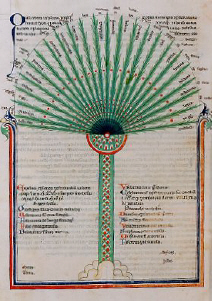The philosopher who was to construct that system, Marsilio Ficino (1433-99), had just completed the first draft of his Latin translation of all thirty-six Platonic dialogues when Bessarion’s In calumniatorem Platonis was completed in 1469. Like many others, Ficino wrote to the cardinal to congratulate him on his treatise, from which he clearly learned a great deal. Adopting Bessarion’s figurative method of reading the dialogues, Ficino insisted that Plato’s doctrine of the transmigration of souls should be interpreted in a moral key, as an allegorical representation of what happened to those who behaved like animals. Similarly, passages describing Socrates’s sexual passion for his young disciples were, in Ficino’s view, marvellous allegories, ‘just like the Song of Solomon’.
Although Ficino relied on the work of the earlier humanist translators of Plato, especially Bruni, he did not share their stylistic concerns. He simply wanted to make his translations as accurate and clear as possible, which meant employing an unadorned Latin and not avoiding useful philosophical terms just because they were unclassical or non-Ciceronian. The fact that Ficino’s version remained the standard Latin translation of Plato until the nineteenth century is sufficient testimony of his success. He also made advances in the analysis of Platonic works. Instead of mining the dialogues for isolated nuggets of ethical wisdom, as the humanists had taught their students to do, he offered complex and coherent analyses of themes—metaphysical and epistemological as well as moral—which ran through the entire corpus.
Humanists quickly began to take account of Ficino’s work, which inspired new interpretations of classical literature. Cristoforo Landino (1425-98) used Ficino’s philosophical ideas in his exegesis of Vergil’s Aeneid, which he saw as a Platonic allegory of the soul’s journey from sensuality and hedonism, symbolized by Troy, to a life of divine contemplation, represented by Italy. Ficino was himself influenced by humanists, sharing many of their prejudices about contemporary scholastics, whom he referred to as ‘lovers of ostentation’ (philopompi) rather than ‘lovers of wisdom’ (philosophi). Like Bruni and Poliziano, Ficino accused so-called Aristotelians of not understanding the texts they professed to expound, reading them as they did in barbarous medieval translations. He also displayed a humanistic distaste for the logical nitpicking to which scholastics were addicted, leaving them little time, he felt, for more serious philosophical endeavour.
Not that Ficino was a stranger to scholastic Aristotelianism. His early university training in logic, natural philosophy and medicine gave him a thorough grounding in Aristotle, Averroes and Avicenna, not to mention more recent writers such as Paul of Venice. Although he soon turned against most of the ideas and doctrines associated with this tradition, it left a lasting impact on his terminology and method of argument: there is a definite scholastic feel about the presentation of most of his treatises. De vita libri tres (1489), Ficino’s most popular work, contains many scholastic elements. Book II, on methods of prolonging life, borrows liberally from the thirteenth-century English Franciscan Roger Bacon; Book III deals with medical astrology, as transmitted to the medieval West by Arabic thinkers, and also develops a theory of magic based on the doctrine of substantial form elaborated by Thomas Aquinas and other scholastics. Even in his Platonic commentaries scholastic ideas often make an appearance: his defence of the superiority of the intellect to the will in the Philebus is taken verbatim from Thomas.
Although significant, this scholastic strain in Ficino’s work was overshadowed by ancient Neoplatonism. The philosopher whom he most revered after Plato was Plotinus, the founder of Neoplatonism, whose Enneads he translated and commented upon. He also translated works by Proclus, Iamblichus, Porphyry and Synesius, all of whom helped to shape his understanding of the Platonic corpus. By promoting Neoplatonic interpretations, already ventilated to a certain extent by Bessarion, Ficino altered the Western perception of Plato, transforming him from a wise moral philosopher into a profound metaphysician.
It was Plotinus who first systematized Platonic ontology, dividing reality into a series of hierarchical levels of being or hypostases, extending from the highest, the transcendent One, which was above being, to the lowest, matter, which was below it. This metaphysical scheme was taken over, with various modifications, by the later Neoplatonists, who used it, as Plotinus had done, to explain the deepest layers of meaning in the dialogues. Proclus, for instance, saw the
Parmenides as a metaphysical work dealing with the nature of the One and in particular its ontological priority to being. According to the Neoplatonists, being was co-terminous not with the One but with the second hypostasis, Mind, for it was in Mind that the Platonic Ideas, the primary components of reality, were located. Ficino adopted this view of the Parmenides, treating it as a masterpiece of Platonic theology, in which essential truths about the One—God in Ficino’s Christian version of the scheme—were revealed.
